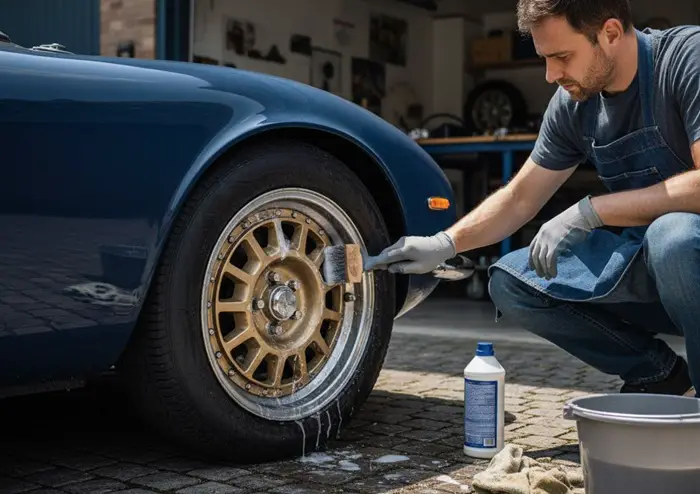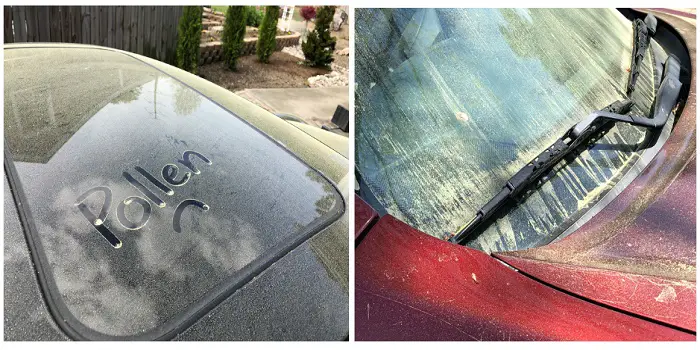
No doubt, the tires of cars with their rims enhance the quality of their appearance. Not only just aesthetically but also it improves the performance of cars.
Wheels and rims of many cars are today made of magnesium as it is lightweight and is good for easy maneuvering.
If your old magnesium wheels look like they’ve been through a few too many road trips and moon landings, you’re not alone.
Over time, oxidation, grime, and brake dust can turn that once-dazzling metal into something that looks more “barn find” than “track ready.”
But don’t worry — bringing them back to life isn’t rocket science (even if the metal once helped build planes).
With the right mix of patience, elbow grease, and a few smart cleaning tricks, you can make those vintage mags gleam again — and maybe even earn a few jealous glances at the next car meet.
Understanding Magnesium Wheels
In short, they are called “Mag rims” or “Mag Wheels” because they are made of Magnesium.
Originally, magnesium wheels were built for racing cars, due to their ergonomic design and lightweight nature.
Over time, it caught the attention of the general public as well, and people started using these Mag wheels for their cars as they improved their car’s look, and they loved showing it off.
As time flies by, the definition of “Mag wheels” has grown, and it includes aluminum wheels as well.
Due to the following advantages, like,
- Lesser weight
- Good acceleration,
- Improved steering control and
- Better braking power
In comparison with steel wheels, Mag wheels are priced slightly higher. Therefore as a substitute, these wheels can also be used.
How to Clean Old Magnesium Car Wheels?
No matter what wheels you roll with, keeping them clean isn’t just about looking sharp — it’s about performance, longevity, and pride.
Especially with magnesium wheels, you’re dealing with a rare breed of metal that’s both stunning and temperamental.
They reward proper care but can turn dull, corroded, or downright cranky if ignored for too long.
So, if your old mags have seen better days, here’s how to give them the VIP treatment they deserve.
Step 1 – Wash and wipe
Start with the basics: a solid wash. Blast the surface with a hose or pressure washer — think of it as giving your wheels a mini spa day.
Mix a mild automotive detergent with warm water and let it cut through the surface grime, dust, and old road muck.
Don’t go nuclear with harsh chemicals; magnesium is a delicate diva and doesn’t appreciate being stripped raw.
Once rinsed, gently wipe everything down with a soft microfiber cloth. You’ll already notice they’re breathing easier.
Step 2 – Apply a degreaser
Now we get into the gritty details. Apply a good-quality, magnesium-safe degreaser to tackle the sticky bits — oil, brake dust, and old residue that laugh at regular soap.
For tight corners and hard-to-reach spots, grab a soft-bristled toothbrush (yes, an actual toothbrush — your wheels deserve that kind of attention).
If some areas are extra snug, wrap a clean cloth around a thin stick or detailing brush and work your way in.
The golden rule here: be gentle. Magnesium scratches easily, and those tiny scars can turn into big eyesores later.
Think of it less like scrubbing a pan and more like polishing a vintage watch.
Step 3 – Sand lightly, clean and finish
Once the dirt’s gone, it’s time to deal with surface blemishes.
Use ultra-fine sandpaper (around 1000–1500 grit) and go easy — you’re aiming to smooth out oxidation and small marks, not to give the wheel a new shape. A light hand and patience go a long way here.
After sanding, clean the surface again with a specialized wheel cleaner or a mild mix of vinegar and water to neutralize any residue.
Finish it off with a buffing pad or microfiber towel to bring back that soft metallic glow.
For the final flourish, apply a dedicated magnesium wheel polish — it’ll not only enhance the shine but also add a protective layer against oxidation.
Once you’ve polished them to perfection, you can optionally seal the deal — literally.
Use a wheel sealant or ceramic coating made for magnesium to keep out moisture, brake dust, and grime. It’s like sunscreen for your wheels.

What Will Clean Magnesium Alloy Wheels in My Car Best?
The best way to clean your aged magnesium alloy wheels and rims is by using a pH-balanced wheel cleaner that’s specifically safe for magnesium or uncoated metal finishes.
Avoid acidic or alkaline cleaners—they can corrode the soft metal surface. A mild soap-and-water solution or a cleaner meant for bare aluminum or magnesium alloys is usually the safest bet.
Start by rinsing the wheels thoroughly to remove loose dirt and brake dust.
Then, use a soft bristle brush or microfiber cloth to gently scrub away any remaining grime. Never use steel wool or abrasive pads, as they’ll scratch the surface and dull the finish.
Alternatively, you can also use some of these commercial products to refurbish lightweight magnesium alloy wheels:
1- Aluminum Brightener
Aluminum Brightener is a strong acid-based cleaner designed to remove oxidation, stains, and brake dust from bare metal surfaces.
While it works wonders on tough grime, it can be too harsh for magnesium wheels if not diluted properly. Always test a small area first and never let it sit too long.
Rinse thoroughly after use to prevent pitting or discoloration. It’s best used only when your wheels are heavily oxidized and standard cleaners aren’t cutting it.
2- Mag Wheel Cleaner Acid
This type of cleaner is typically acidic and aggressive, made to dissolve baked-on brake dust quickly.
However, magnesium is a softer and more porous metal than aluminum, so acid cleaners can easily eat into the surface and cause permanent damage.
If you must use one, dilute it heavily and apply for just a few seconds before rinsing. In most cases, it’s safer to avoid these entirely for magnesium wheels.
3- Scrub Free Bathroom Cleaner
Surprisingly, some detailers use Scrub Free Bathroom Cleaner as a mild degreaser for wheels because it’s non-abrasive and cuts through soap scum, grime, and light oxidation.
It can work for a quick clean if you’re in a pinch, but use it cautiously—it’s not designed for metal finishes and might leave residues. Always rinse thoroughly and dry completely afterward.
4- Eagle One Etching Mag Wheel Cleaner
This cleaner is well-known for restoring shine to neglected mag and aluminum wheels.
However, it’s not suitable for uncoated magnesium because it’s acid-based and can cause etching or dark spots.
If your wheels are coated, it can be effective for deep cleaning; otherwise, stick with pH-neutral alternatives. Always follow up with a protective wax or sealant after cleaning to prevent corrosion.
5- Search Mag Wheel Polishing Near Me
Searching for commercial mag wheel polishing services locally is the fastest way to find local professionals who can bring your tired magnesium or alloy wheels back to life.
These experts use specialized tools, polishing compounds, and protective coatings to remove oxidation, scratches, and dullness — restoring that factory-fresh mirror shine without damaging the delicate surface.
Many shops also offer refinishing, repainting, or clear-coating services to keep your wheels looking new for longer.
Whether you drive a vintage classic or a modern sports car, getting your mag wheels professionally polished saves you hours of DIY effort and delivers a flawless, lasting finish.
Can I Use Vinegar to Restore Forged Mag Wheels in My Vehicle?
You can use vinegar to clean and lightly restore forged magnesium wheels, but only with caution — and it’s definitely not a one-size-fits-all solution.
Vinegar is mildly acidic (acetic acid), which helps dissolve surface oxidation, stains, and mineral buildup.
When diluted properly — usually one part vinegar to three or four parts water — it can gently lift grime and bring back a bit of brightness to dull magnesium surfaces.
But, if used too strong or left on too long, vinegar can start eating away at the protective oxide layer, causing more harm than good.
- Before applying vinegar, make sure the wheels are thoroughly washed with mild soap and water to remove loose dirt.
- Then, use a soft microfiber cloth dipped in the diluted vinegar solution and gently rub the affected areas.
- Avoid soaking the wheels or letting the vinegar sit — magnesium reacts quickly, and you don’t want to encourage corrosion.
- After cleaning, rinse the wheels thoroughly with clean water and dry them completely to neutralize any remaining acidity.
- Once dry, it’s smart to follow up with a magnesium-safe polish or protectant. This not only restores shine but also creates a thin barrier that keeps moisture and oxygen from causing further oxidation.
Remember that if your wheels have a clear coat or protective finish, vinegar can dull or strip it — so test it on a small, hidden area first.
In short, vinegar can be a decent quick-fix cleaner for lightly oxidized forged magnesium wheels, but it’s not a deep restoration solution.
For heavy corrosion or pitting, you’ll need a proper magnesium restoration kit, fine sanding, and polishing compounds — the kind of care that keeps your wheels looking more “classic racer” and less “forgotten barn find.”
Pro Tips to Keep Those Magnesium Wheels Gleaming for the Long Haul
You’ve done the hard work for the restoration of magnesium wheels — washed, scrubbed, polished, and brought those old rims back from the dead.
But here’s the thing: keeping them that way takes a bit of ongoing love.
Magnesium isn’t the kind of metal you can just clean once and forget about — it demands regular attention (and maybe a little pampering).
So before you roll off into the sunset, here are a few tried-and-true tips to help your wheels stay shiny, protected, and ready to turn heads for years to come.
1. Avoid Harsh Chemicals – Magnesium Has Feelings Too
Stay away from acidic cleaners, bleach, or anything that says “industrial strength” on the label.
Magnesium reacts faster than you can say “corrosion,” and harsh stuff will eat away at the protective layer. Stick to pH-balanced or magnesium-safe products.
2. Don’t Leave Them Wet
After every wash, make sure your wheels are completely dry.
Water spots aren’t just ugly — on magnesium, they can turn into oxidation patches faster than you’d expect. A soft microfiber towel is your best friend here.
3. Regular Maintenance Is Key
Don’t wait for your wheels to start looking like relics from a scrapyard.
Give them a quick wipe-down after long drives and a deeper clean every month or two. The more you maintain them, the less work it takes to keep them looking fresh.
4. Handle With Care (Literally)
When removing or reinstalling the wheels, avoid banging tools against them.
Magnesium may be strong but it’s not indestructible, and small nicks or chips can open doors for corrosion.
5. Store Smartly
If your car is off the road for a while, store it in a dry, shaded spot.
Covering your wheels (or the whole car) with a breathable cover helps prevent dust buildup and oxidation — plus, it makes the next cleanup much easier.
FAQs
How to polish magnesium car wheels?
To polish magnesium wheels, first thoroughly clean and dry them.
For an un-coated, raw magnesium finish, you may need to sand out imperfections starting with a coarser grit and progressing to a very fine one (e.g., up to 2000 grit).
Next, apply a magnesium or aluminum polish with a soft cloth or polishing cone.
Work in small sections, then use a clean microfiber towel to buff the wheels to a brilliant shine. Finish with a protective wax or sealant.
What is the best way to clean mag rims?
The best way to clean mag rims is to use a pH-neutral or non-acidic wheel cleaner specifically designed for alloy wheels.
Start by rinsing off loose dirt and brake dust with a hose. Spray the cleaner on a cool wheel and let it dwell for a few minutes (do not let it dry).
Use a soft-bristled wheel brush and detailing brushes to gently agitate and clean the face and barrel of the rim. Rinse thoroughly with clean water and dry with a microfiber towel to prevent water spots.
How to Remove Rust from Mag Wheels in My Car?
The visible “rust” on mag or alloy wheels is usually iron contamination from brake dust, not the magnesium itself corroding.
To remove it, use an iron-decontaminating spray (often purple-colored and foul-smelling). Spray it on, let it react and turn color, then agitate with a soft brush, and rinse well.
For minor surface stains, a paste of baking soda and water or white vinegar may also work with gentle scrubbing.
Using Muriatic Acid to Clean Magnesium Wheels – Is it Safe?
No, muriatic acid is not safe for magnesium (or most aluminum) wheels and is strongly discouraged.
Muriatic acid (hydrochloric acid) is extremely corrosive and can permanently etch, damage, or dull the finish, especially on coated or polished surfaces. It is also hazardous to use, producing noxious fumes.
Always use pH-neutral or acid-free cleaners to safely clean your wheels and preserve their finish.
Conclusion
Caring for old magnesium wheels requires a delicate, educated approach to avoid permanent damage.
Due to magnesium’s reactive nature, the golden rule is to avoid harsh, acidic, or caustic cleaners like muriatic acid at all costs, as they will aggressively promote corrosion.
Always opt for pH-neutral, non-acidic cleaners and a soft brush for gentle scrubbing. The real threat is brake dust—the ferrous particles lead to corrosion (“rust”) and pitting.
Using a specialized iron-decontaminating spray is the safest, most effective way to dissolve this contamination.
Finally, protection is paramount. Once the wheels are clean and dry, immediately apply a high-quality wheel wax or sealant.
This protective barrier is essential to prevent moisture and road salts from attacking the metal, ensuring your vintage magnesium wheels retain their strength and classic aesthetic for years to come.

Based in Orem (Utah) John Paterson graduated from Utah Valley University and has begun writing in 2009. He has a large wealth of experience in writing articles related to cars, automotive repair, wheels, cleaning/maintenance, and much more. He has also written instructional articles in a similar niche for a few online publications as well. Currently, he works as a mechanic in his personal garage shop where he loves serving his countrymen from his heart.




